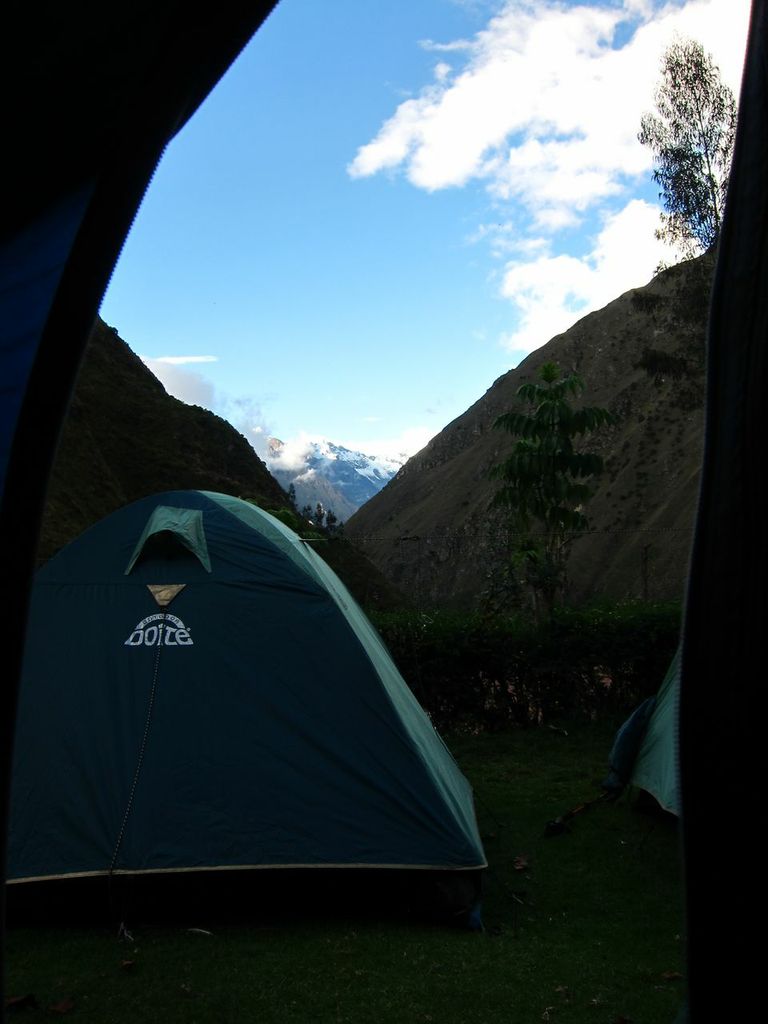The Inca Trail
A 4 day, 26 mile (43 km) trek to the Old Mountain, Machu Picchu
Inca Trail: Elevation Map
While Machu Picchu (Quechua for Old Mountain) is at only 2,400 m, the highest point on the trek is at 4,200 m, which is about 2.6 miles above sea level. In order to prepare for the hike, we had spent three days in Cusco, which is at an elevation of 3,400 m (11,200 ft, over 2 miles). At that altitude, most people will feel that it is harder to breathe and feel a slight headache while some folks will come down with nausea. We took it easy and survived the trek in one piece.
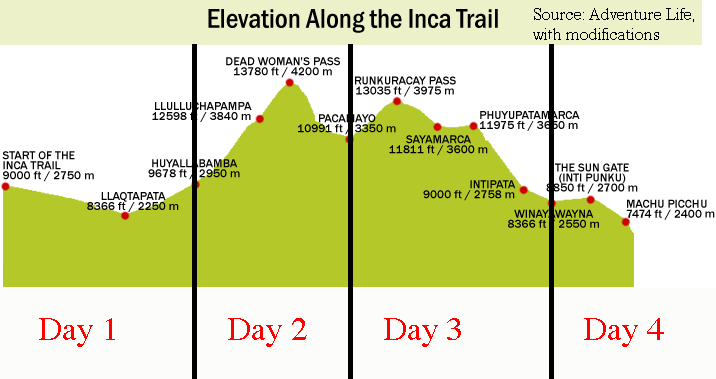
Also, because prices are listed here, just wanted to note that 1 USD is equal to about 2.8 Peruvian Nuevo Sol (plural Soles, pronounced So-lays). The symbol is S/.
April 11, 2014 -- Since the guides were going to pick us up from the hotel between 5:20 am and 6 am, we woke up at 4:30 am to finish packing and with the hope of grabbing a quick breakfast (available at 5 am). We managed to check out before 5:15 am and left our extra luggage with the receptionist. Fortunately, the guides did not arrive until 5:35 am so we were able to eat a bit. CL focused on fruit (papaya, honeydew, cactus fruit), and manzanilla tea (chamomile), while K ate sausages and had milk with coffee (2/3 milk, 1/3 brewed instant coffee).
Because the bus needed to pick up other trekkers too (16 of us in total), it took awhile to get on our way. About 1.5 hours later, we arrived at Ollantaytambo (O-yan-tay-tam-bo) to stop for breakfast and pick up last minute supplies. This really was feeling like the start of the Oregon Trail game. Some trekkers bought wooden broomsticks to use as hiking sticks. The assistant guide, Janet, kept reminding everybody to get ponchos. We were the only pair that did not get ponchos as K had read that ponchos were pretty useless by themselves - they flap around in the wind, and if you don't get them out in time, your stuff gets wet anyway. Instead, we had wrapped everything in plastic bags so that even if our backpacks got wet, the stuff inside would be dry. We also wore rain jackets and water proof athletic pants.
Since we weren't that hungry, and also because the people who ordered pancakes and eggs got some not so appetizing looking dishes, we decided not to order anything big. We saw an espresso machine and a burr grinder so we ordered two cafe cortados (for only S/. 5 each!), but we were disappointed when we got served cafe con leche instead. This is like ordering a cappuccino (something with foam) and getting a regular coffee plus a jar of milk instead. Our guess is that the person serving did not know how to use the machine. At least the leche (milk) was warm! We hurried back onto the bus so we could munch on our secret stash of Monasterio mini-baguettes and Tierra Viva baby bananas. (Monasterio was where we had dinner the night before, and Tierra Viva was the name of our hotel).
After breakfast, it was another hour or so past farming communities and a snow-capped mountain to Km 82, the end of the road, and the start of the trek.
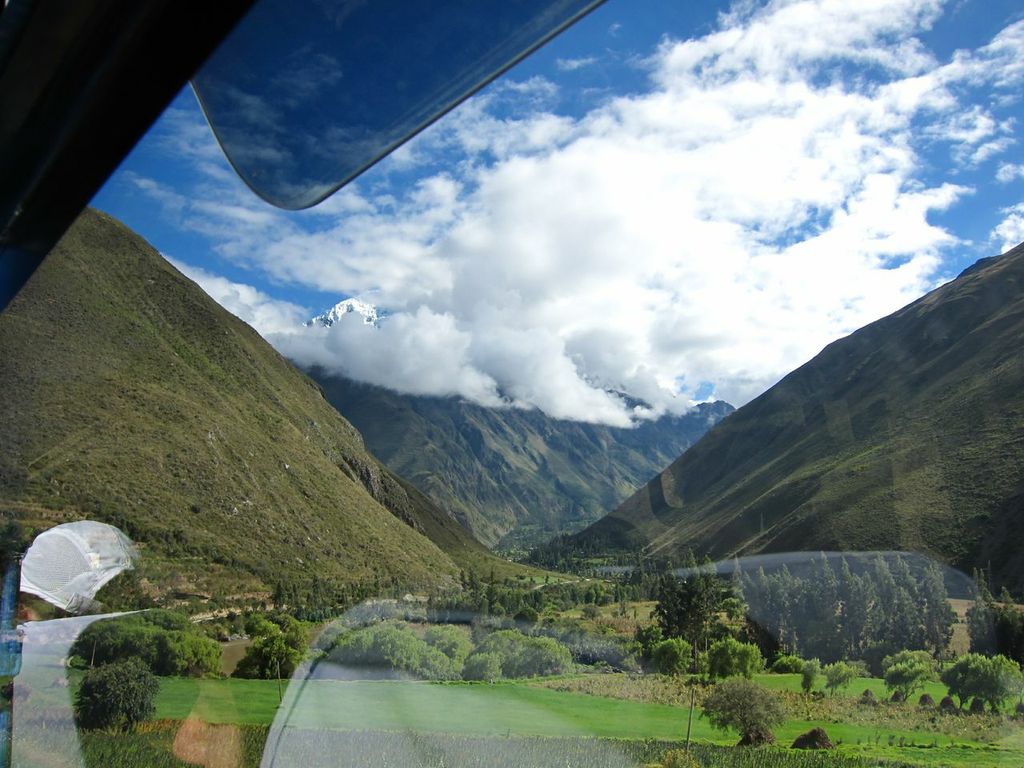
We got our sleeping bags and sleeping mats from the trekking company and managed to squeeze in the two sleeping bags into our porter's duffle bag. We also left a sleeping mat for him to carry since that would still be within the weight limit of 6 kg that we had paid for (the max weight limit a porter can carry is regulated at 20 kg, and we could have paid for a max of 12 kg since they have to also carry their own items). In some ways, having a porter is luxury backpacking. When K went in college, she and her dormmates had to carry all of the tents, cooking equipment, sleeping bags, and food. However, that hike was not at such high elevation.
It was much warmer than in Cusco, owing to the lower altitude and later hour, so K sought to change to only 1 pair of pants, the athletic pair, because she was wearing a double layer with leggings underneath. However, the only bathroom charged 1 sol (which CL used, but K did not), and K was cheap and didn't want to pay if she was just going to change clothes. So K had to hike in just the leggings instead, since there was no place with enough privacy to take off the leggings and just wear the athletic pants.
Once past the passport checkpoint (where we got our first Inca Trail stamp!) and the bridge over the Vilcanota River, we took a group photo (around 10 am). The guide said it was a good idea to do it while we were clean and full of energy.
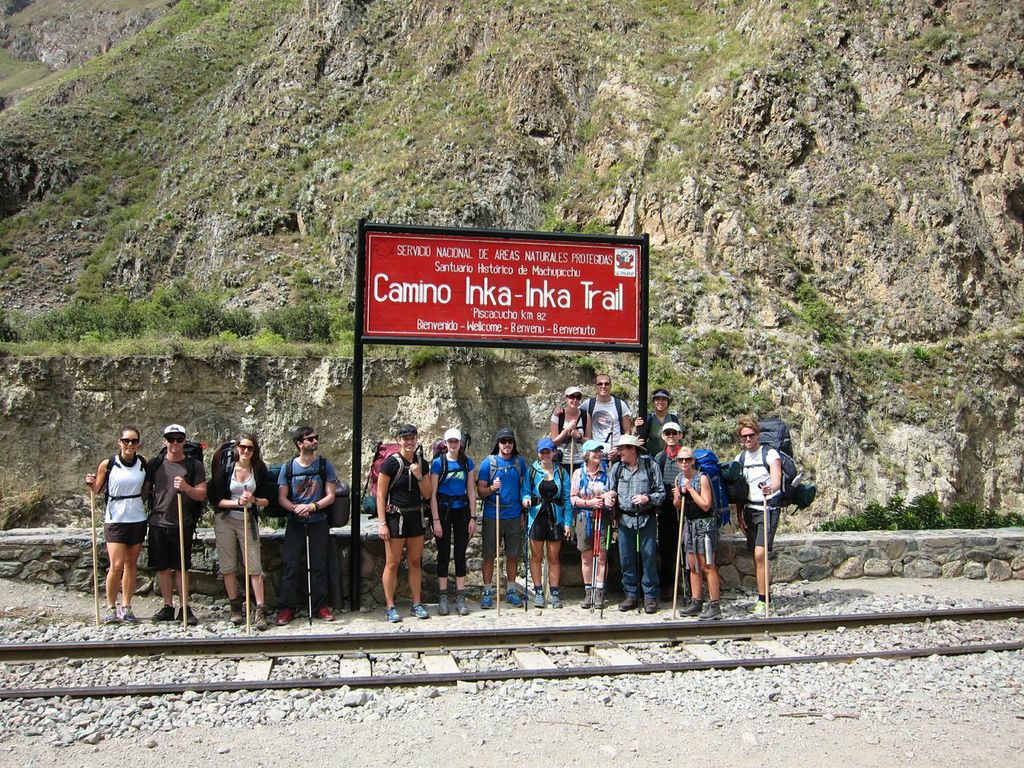
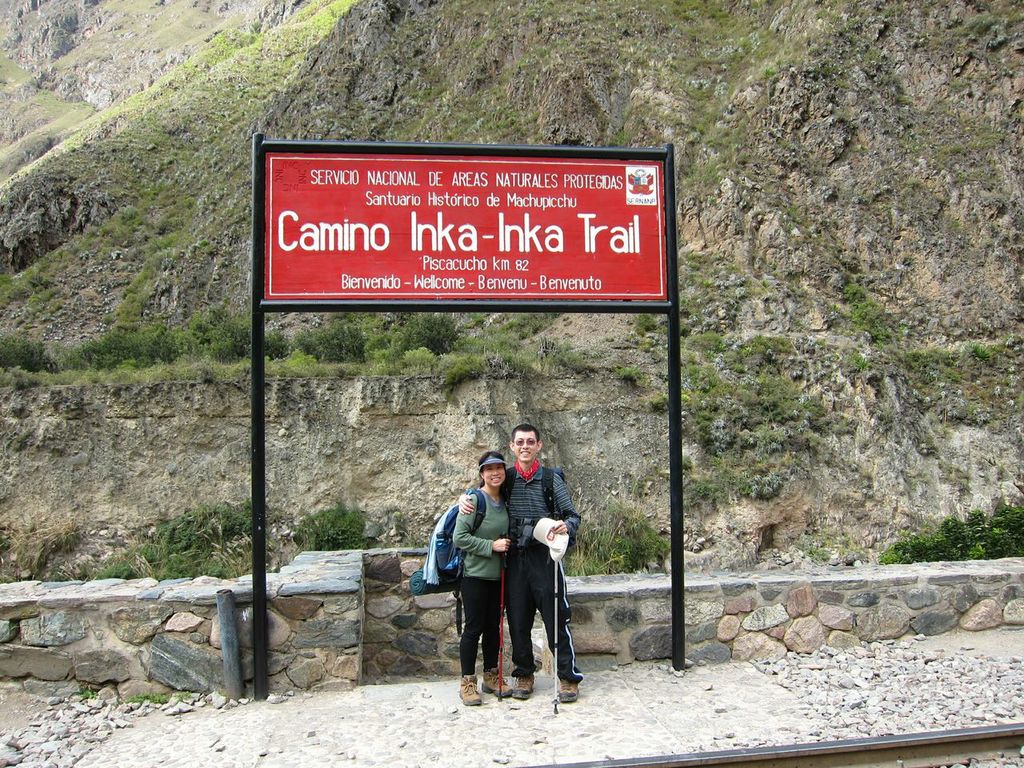
Almost immediately, it was uphill. Fortunately, it did not last long before we got to a green area for intros. There were people from Oregon, Australia, South Africa, Quebec, the UK (who had lived in Perth, Australia for a year), and Norway. We were on the shortest trip (10 days), while everyone else was traveling for 1-3 months, exploring multiple countries in South America. We also discovered that we were almost the oldest in the group. Most folks were in their early or mid 20s. One pair was on their honeymoon. Only the Quebec couple were about our parents' age, and they were more experienced than us in trekking, with the husband having once made it to Everest's Base Camp (5,150 m). After another short hike, we had another break in the shaded area of someone's house along the trail (where snacks, drinks, and toilet access could be paid for). K was surprised how frequently the group rested (as led by the guide). Based on how everybody complains about the Inca Trail's difficulty, she was expecting it to be torturous the entire way.
Because it was an easy path on a sunny day, people were chatty. Suddenly, we hit a hill that seemed to keep going up, and all the chatter stopped as people just focused on breathing and climbing the hill.
K was motivated because she had noted that the time was near 12 noon, and was certain that lunch was at the top of the hill.
Alas, it was not, but we did get to stop at another rest area that was similar to, but larger than the previous one, for another 20-25 minutes, ostensibly to give the chef and
porters more time to set up lunch before we got there. Here, K was glad she and CL stuck to long pants and long sleeves (since we were afraid of insect bites). Most folks had switched to shorts and short sleeves or sleeveless, and were starting to feel cold in the shade. Milling about the area were kittens and chickens. We ate a baby banana (for electrolytes, insisted CL). While we rested, K overheard Janet explaining that, after lunch, it would be 1.5 hours hiking, of which the first 20 minutes would be uphill, before there would be cookies and tea time. Except, K heard wrong. It was 1.5 hours UNTIL lunch time, of which the first 20 minutes would be uphill.
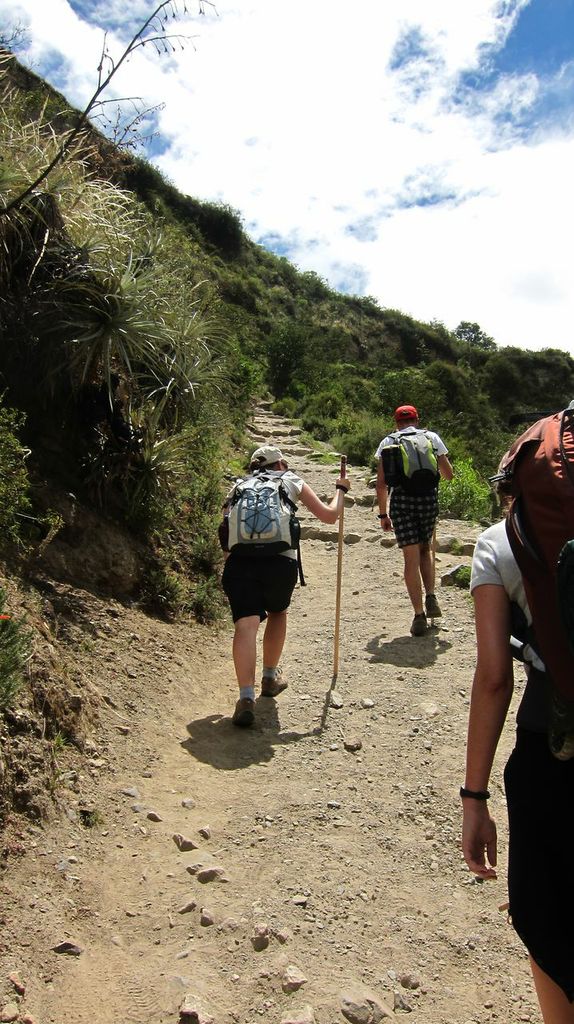
We did see one pour soul being carried back by a donkey. K originally thought that there were donkey tours available (that is, ride a donkey along the trail to Machu Picchu), but it turns out he probably was sick from the altitude, and could not continue the trek. In extreme situations, some people can be rescued by a helicopter, but it depends on the location, since some parts of the trail are under canopy.
We reached a view of Llactapata (Yaak-ta-pa-ta) and sat for a brief history of the area. This is where the two valleys diverged. One, the commercial route, which is the route the train takes, would require only six hours by foot to reach Machu Picchu. The other route, the religious pilgrimage one, the one we paid for, would require FOUR days' hike. Llactapata was built to control both passages.
We also learned how, rather than the few hundred Spanish Conquistadores defeating the millions of Quechuas of the Incan empire with European military prowess or infectious diseases, it was that the Quechuas (local people), ruled by the Incans, were split and some fought for independence from the Incans, and the Spanish took advantage of the opportunity to overthrow the ruling class.
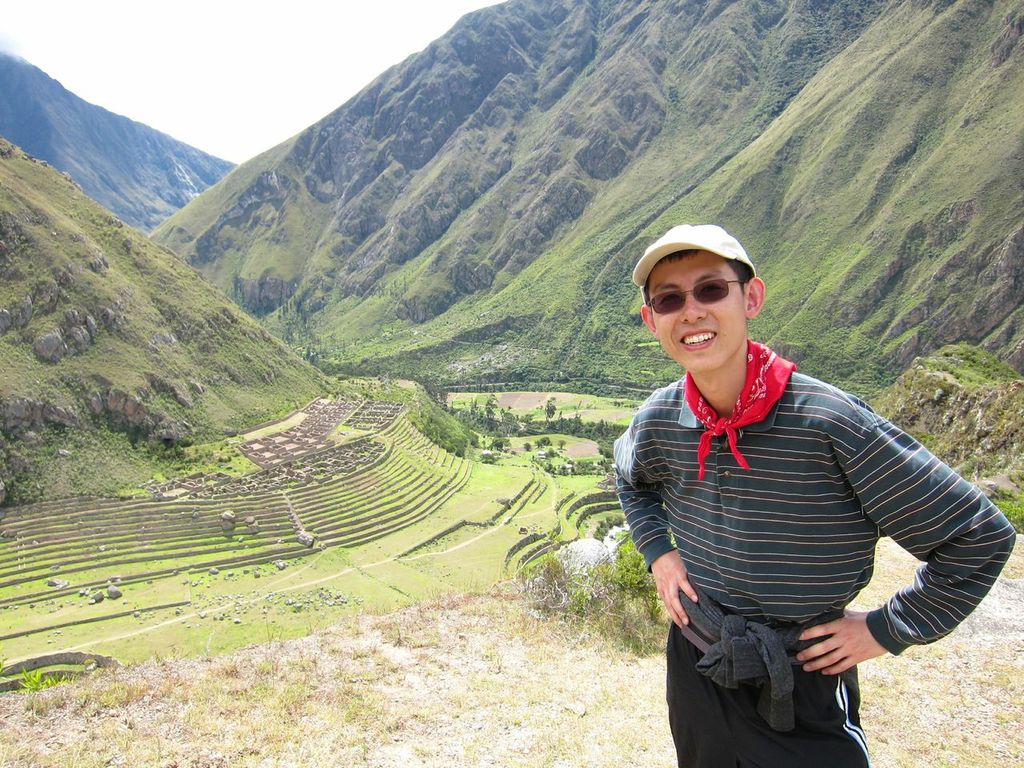
Then, it was time to walk to lunch. K was very excited, because she thought lunch was five minutes away.
Except it wasn't. On our way back to the trail, we passed by a hill fort, Huilla Raccay, that served as a lookout for the two valleys, since it was higher than Llactapata.
As we hiked, we got great views of Mount Veronica (Wakay Willca in Quechua, meaning Sacred Tears).
According to Janet, this was the first time in 3 months that the mountain was visible from under the clouds. This was the same mountain that we saw from the bus ride.
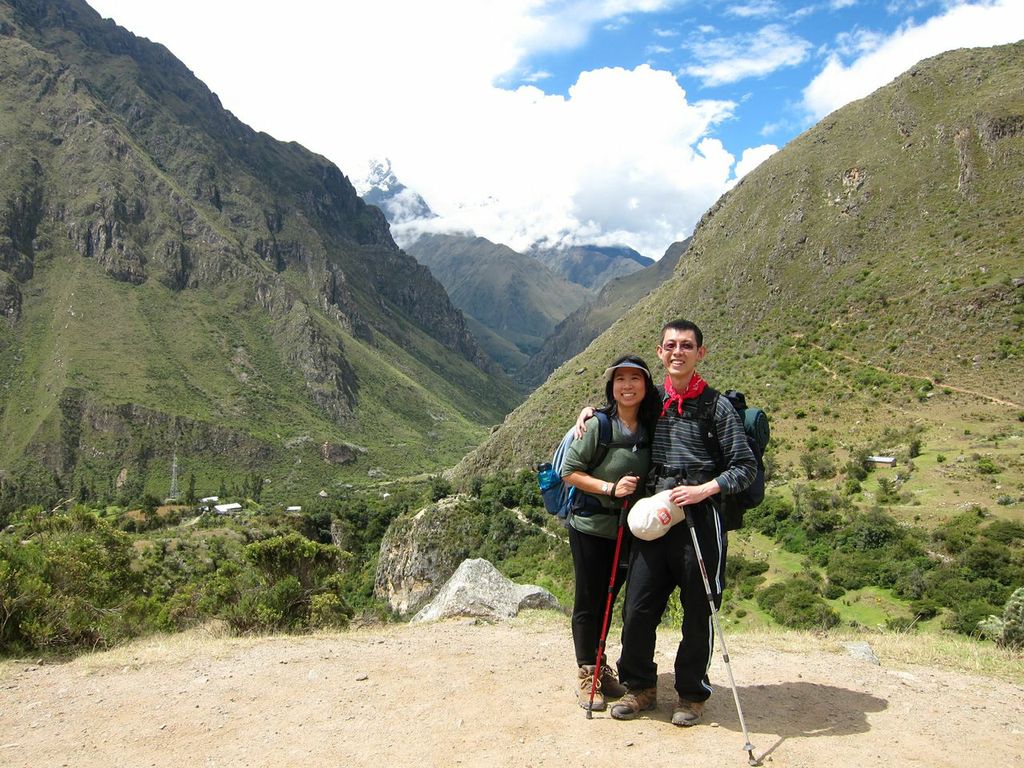
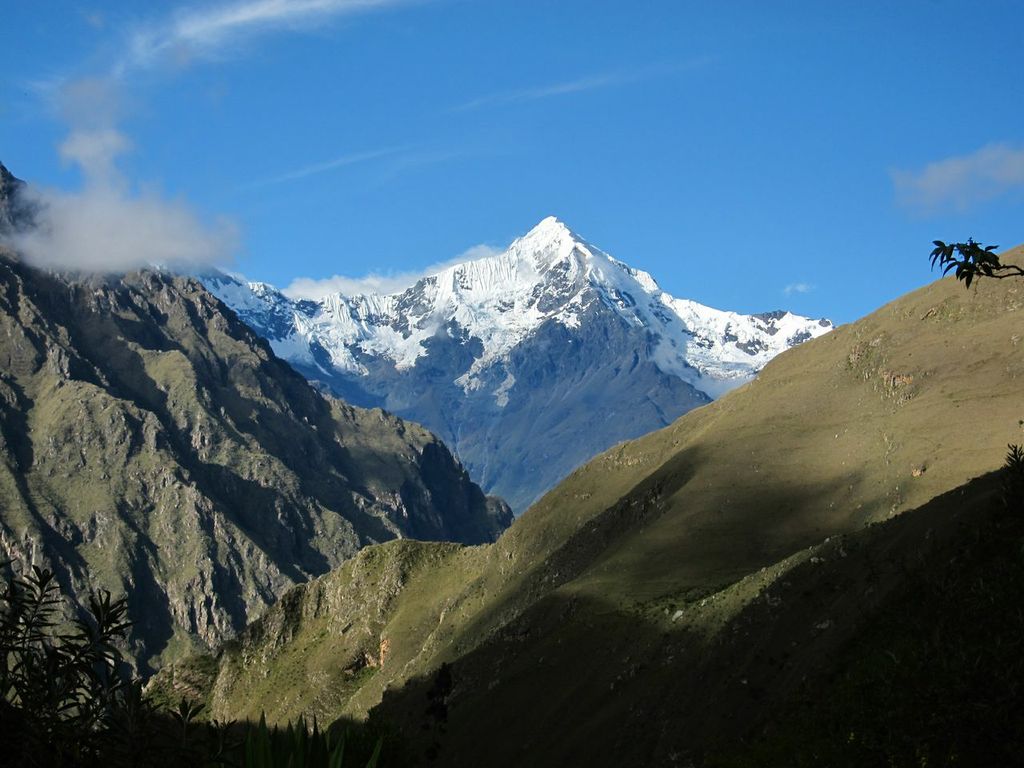
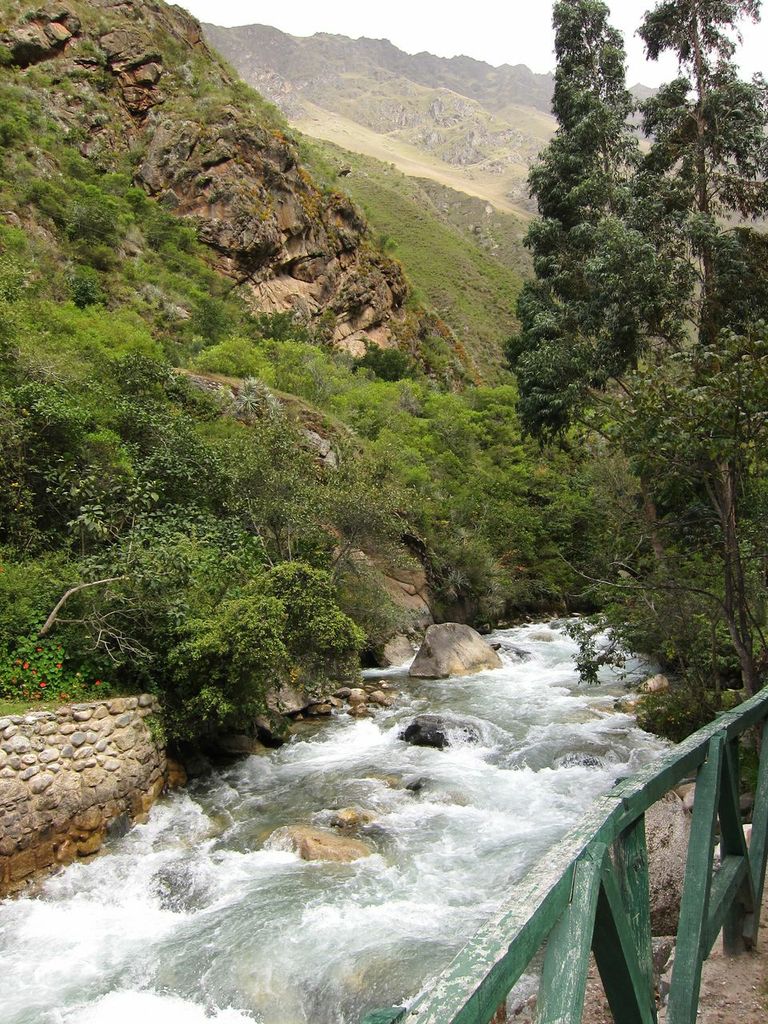
Finally, at the lunch site (around 1:45 pm), we were given rehydrated peach juice (still warm from the boiled water), a tarp for us to place our backpacks on, water and soap to wash our hands (and towels!), before settling into the large dining tent.
The tent barely fit the 16 of us plus our 2 guides, and folding chairs and tables. This tent is also where the 21 porters and chef spend the night. We were all quite surprised when the first course (yes, there was coursing!), was passed down the table: Tiny saucers of freshly made guacamole topped with white cheese, and four chips tucked in, one on each side.
We also got shrimp and potato soup. While most people got one shrimp, K was lucky and got two, both of which she gave to CL because they had heads.
In exchange, CL had given K the cheese topping from the guacamole. The soup also came with delicious garlic bread.
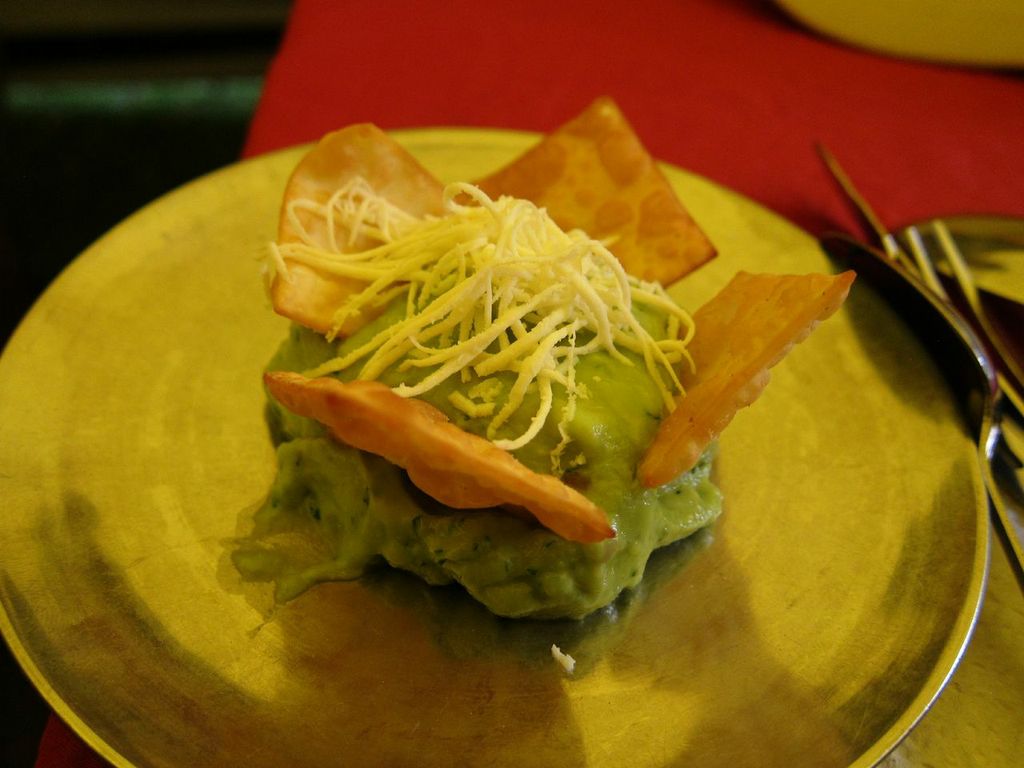
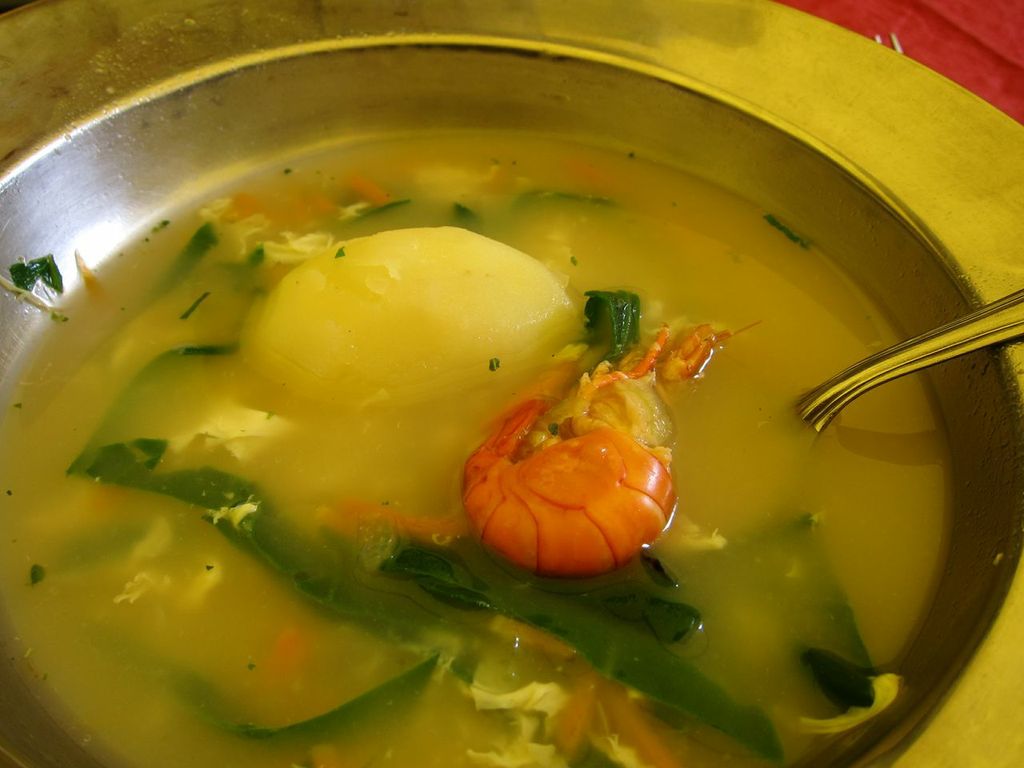
The main course came in platters for passing (no plating), and included cheese-topped baked potatoes, quinoa, fried trout with cream of mushroom, and vegetables (carrots, shallots, and beans). Finally, to wash it all down, we had muña tea. Muña is an Andean mint, and good for digestion. In the meantime, there were some really aggressive kittens, one of whom leaped onto CL's knee because it wanted to be fed. The kittens crawled around under the table and bumped into people's legs, constantly looking for opportunities to jump onto laps. Because it started raining outside, we couldn't shoo them out. In fact, a squawking chicken wandered into the tent. By the time we were ready to head out around 3 pm, the rain had mostly stopped. But just to be safe, we put on rain gear. That made the next part of the trek feel really hot.
Previously, we hiked in a group, but after lunch, we were given the opportunity to go at our own pace, and to meet up at a rest stop. CL and K finished #4 out of 8 pairs, and it felt like Amazing Race where we wanted to make sure we weren't last, but didn't use up all our energy on the first day. This rest stop had cute black puppies, and one older dog, who was possibly the mother. We were all tired, but one guy in our group was so tired that he nearly fell asleep in the grass. Once everybody had rested a little, we continued for the last portion of the trek, which was littered with horse poop. We passed by camp sites and saw a porter get cited for possibly carrying too much weight. The fines are there to prevent overloading of porters, although it's not clear how effective they are if they fine the porter and not the company that overloads them. Towards the end of that day's hike, we crossed a bridge with donkeys on three sides (left and right of the entrance, and left of the other side). While CL went to take photos, K went to pet a baby donkey (along with Janet). The top of the fur was matted, and not soft. However, the sides were fluffy! Further up the hill, the group was blocked by a ruminating donkey. He was eating grass off the side of the path, and standing in the way, which meant we trekkers had to scramble over a large rock to get past him.
Our camp site was in the village of Wayllabamba (3,000 m), past a church, and overlooked corn fields. It had its own chicken roost too, with the hens sitting along a fence, and the rooster guarding them.
Normally, this camp site is a farm by a stream and were just sleeping in the grassy area of their yard. As we were the last to arrive (from pausing to take photos), we got the leftover tent. It wasn't bad since they're all about the same. It felt really nice to pull of the hiking shoes, wipe down, and switch to new socks and sleeping clothes. We sat down and rested before dinner time. The toilet had squatty potties, but flushed! Instead of a button, the flush is with a string because the water tank is above. Anyway, the way up to the toilet (which was in a separate outhouse) was secured by a fence. It was supposed to be kept shut so that the donkeys above would stay where they grazed (by the outhouse) and not come down into the camp area. However, someone left it open and a rooster ran down it, as did a dog, before the gate was shut again. Sunset was very nice -- we could see Mt Veronica from our tent. Reminding us that we were on a farm, a chicken also randomly walked by our tent. To rest, we started writing our journal and took a nap before dinner time.
Dinner (6:45 pm) was Semolina soup, Rice and Chilies, Chicken + Beef + Vegetable skewers, with Andean Pear puree for dessert. (Sorry, we left the camera in the tent so no photos from dinner).
Partway through the meal, a moth flew into the tent, and was attracted to the gas lamp. It kept flying closer until suddenly, it hit the lamp and the light became very dim (it was a big moth). After a few moments, the moth caught fire. When it burst into flames, the tent lit up again. It was like a moth cremation! Afterwards, we had our choice of tea (Manzanilla, Anis, Black tea, and Coca leaves). We chose Manzanilla because it didn't have caffeine and because K is not partial to licorice.
As a side note, so you know what's normal, one guy in our group missed out on dinner because he was feeling sick (likely from the altitude + exertion).
After dinner, it was very dark so we just tried to go to sleep. Originally, we had laid the sleeping bags parallel to the tent door, but this was also parallel to the hill slope, so we kept rolling down. When we had enough rolling (it would have been funny, but we were trying to sleep), we rotated 90 degrees with our feet to the door, and that worked better. We could hear other people talking in the tents next to us (they were clearly not sleepy), so it was hard for us to sleep. After the others stopped talking, the dogs kept barking and the rooster started crowing, even though it was not even close to dawn. The sleeping bag was very warm at first, but in the middle of the night, it got quite cold, so we didn't sleep that well. In fact, because of the cold and the sunrise, we easily awoke before our 5:45 am wake up call.

